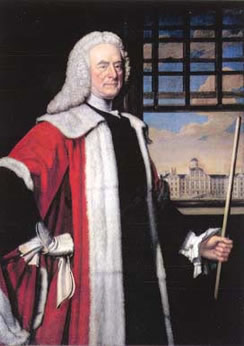
Portraits from the Royal Infirmary of Edinburgh Boardroom
George Drummond, 1687-1766
Connection with the Royal Infirmary:
One of the first Managers and main fundraisers
Artist:
John Alexander, 1687-1766
Date of Portrait: 1752
Without doubt the most important single work of art in the Infirmary's collection of portraits and busts, this is a nationally significant Scottish painting. Here we see George Drummond, six times Lord Provost of Edinburgh, in his ceremonial robes of office. His impassive impression is the mask of a long standing public servant, someone who has "seen it all before". By inclination and ability he was suited to the life of an aedile, a man whose aim was to serve and be useful to his local community.
As well as being very much in the foreground of eighteenth century Edinburgh public life, Drummond also occupies the foreground of Alexander's portrait. He is positioned so that the vertical line of his body is continuous with the upright of the window frame and this composition invites the eye to look beyond the man and to admire one of his greatest achievements: the second Royal Infirmary building.
Designed by William Adam, it was the largest public building of its day in Scotland. The foundation stone was laid in 1738 and, by the time this portrait was painted in 1752, it had only been finished for four years, although patients were actually admitted from 1741 onwards. Originally intended for a maximum of 228 beds, it remained in use until the Infirmary moved to Lauriston Place in 1879. Drummond was instrumental in turning Adam's design into bricks and mortar, having masterminded the campaign to raise both money and materials by voluntary public subscription.
On one level, this painting celebrates one of the greatest achievements of the eighteenth century period known as the Scottish Enlightenment. Edinburgh became a world centre for the teaching of medicine. The Infirmary was the pivotal institution in which the medical theory of the classroom was mixed with practical treatment at the bedside. A story of success, certainly; and one which has been built on since. However, there is another tale to tell about Drummond's role as the "Father of the Infirmary" and features of Alexander's canvas provide us with some tantalising clues to it.
In keeping with many of his contemporaries this moderate man, who worked hard to build Edinburgh's New Town as well as the new Infirmary, had a darker private side. Drummond was drawn to an Evangelical Presbyterianism described at the time as being of the "wild" persuasion, and beneath Drummond's red and white robes of office we can see clothes of a more austere black. During the late 1730s, when the Infirmary was being built, he kept a spiritual diary. As well as revealing a secret religious life which oscillated between the extremes of fervent hope and gloomy despair, it also shows us a man who worked very much for his private interest as well as the public good.
It may not be inappropriate that the hand which grasps the staff of office is here ungloved, given the little known fact that Drummond actually borrowed more money than he gave to the Infirmary and died in debt to it. When he sat for this portrait, the Infirmary was not regarded as the success it was later to become. The new building cost more than the funds subscribed; many of the tradesmen had yet to be paid for their services; there was only enough money to care for a handful of patients and some even doubted the wisdom of building it at all. Perhaps it is no accident that the building seems to cast a shadow over part of his robe. Note also the crack in one of the panes of the window, which is a symbolic as well as a realistic feature of the painting. Drummond's staff is almost supporting the sash, preventing it from crashing down and obscuring the view of what most eventually came to regard as his finest achievement.
While the artist, John Alexander, was being outlawed for supporting the Jacobites during the Forty-Five, Drummond was busy organising the defence of Edinburgh. Afterwards, the rebel painter was forced to live in France for some time before slipping back into Britain to resume his profession. Yet within seven years he was painting the portrait of the loyal Hanovarian. Perhaps Alexander had his own reasons for alluding to the anomalous and darker aspects of Drummond's character in this remarkable portrait.
Designed by the Learning Technology Section, © The University of Edinburgh

